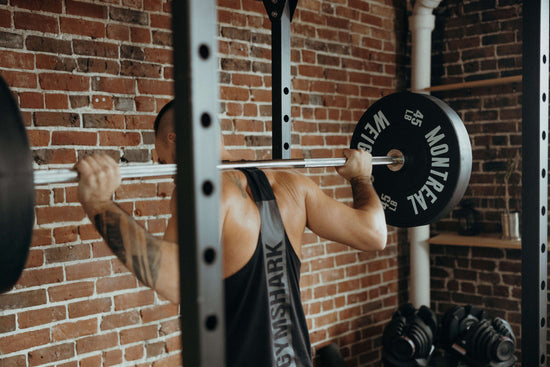Have you ever wondered why your squat depth is lacking? Or perhaps why your posture leans forward involuntarily?
Your ankles are a vital part of your mobility, providing balance, stability, and fluidity of movement. When ankle mobility is lacking, it can limit your range of motion, holding you back from reaching your fitness goals or enjoying daily activities.
By incorporating ankle mobility exercises, you can improve your flexibility, increase your workout performance, and feel more comfortable and confident in your movement. Let's dive into the top ankle mobility exercises to improve your range of motion.
Importance of Ankle Mobility
Why Limited Ankle Mobility Can Be a Problem
What Is the Normal Range of Motion For Ankle Mobility?
How can I improve my ankle mobility?
1. Wall Ankle Mobilization
Why it works: This exercise stretches and mobilizes the calf muscles and Achilles tendon, which can help to improve ankle dorsiflexion mobility.
To perform the wall ankle mobilization drill:
- Stand facing a wall with one foot about six inches away from the wall
- Keeping your heel planted on the floor, lean forward and touch the wall with your knee
- Return to the starting position
- Repeat this movement for 10 to 15 reps before switching sides.
Variations: If you have difficulty keeping your heel on the floor, try placing a small wedge or rolled towel under your heel to elevate it slightly.
2. Ankle Alphabet
Why it works: This exercise improves ankle mobility by activating the muscles and tendons that control ankle movement.
To perform the ankle alphabet exercise:
- Sit with your legs outstretched in front of you
- Trace the alphabet with your toes, using your ankle to move your foot
- Repeat the alphabet three times with each foot
Variations: If you have difficulty sitting on the floor, try performing this exercise while seated in a chair.
3. Toe Raises
Why it works: This exercise strengthens the muscles in the front of the ankle and can improve dorsiflexion.
To perform toe raises:
- Stand with your feet shoulder-width apart
- Lift your toes off the ground, keeping your heels planted
- Hold this position for a few seconds before returning your toes to the ground
Variations: If you have difficulty balancing, try holding onto a wall or stable object for support.
4. Heel Raises
Why it works: This exercise strengthens the muscles in the back of the ankle and can improve plantarflexion.
To perform heel raises:
- Stand with your feet shoulder-width apart
- Lift your heels off the ground, keeping your toes planted
- Hold this position for a few seconds before returning your heels to the ground.
Variations: If you have difficulty balancing, try holding onto a wall or stable object for support.
5. Seated Calf Stretch
Why it works: This exercise stretches the calf muscles, which can help to improve ankle dorsiflexion.
To perform the seated calf stretch:
- Sit with one leg extended in front of you and the other leg bent with the foot resting on the floor
- Place a towel or resistance band around the ball of the extended foot and gently pull the toes towards you until you feel a stretch in your calf
- Hold this position for 30 seconds before switching sides.
Variations: If you have difficulty sitting on the floor, try performing this exercise while seated in a chair.
6. Standing Calf Stretch
Why it works: This exercise stretches the calf muscles, which can help to improve ankle dorsiflexion.
To perform the standing calf stretch:
- Stand facing a wall with your hands on the wall for support
- Place one foot about a foot away from the wall and the other foot behind you
- Keeping your back leg straight, lean forward until you feel a stretch in your calf
- Hold this position for 30 seconds before switching sides
Variations: If you have difficulty balancing, try holding onto a wall or stable object for support.
7. Lunges
Why it works: Lunges help to strengthen the muscles in the legs and can improve ankle mobility.
To perform Lunges:
- Stand with your feet hip-width apart and take a large step forward with one foot
- Lower your back knee towards the ground, keeping your front knee over your ankle
- Push back up to the starting position and repeat on the other side
Variations: If you have difficulty with balance or knee pain, try using a chair or wall for support.
8. Squats
Why it works: Squats help to strengthen the muscles in the legs and can improve ankle mobility.
To perform Squats:
- Stand with your feet hip-width apart
- Lower yourself into a seated position, keeping your knees over your ankles
- Push back up to the starting position and repeat.
Variations: If you have difficulty with balance or knee pain, try using a chair or wall for support.
9. Jumping Jacks
Why it works: Jumping Jacks help to improve ankle mobility by encouraging movement in the ankle joint.
To perform jumping jacks:
- Stand with your feet together and arms at your sides
- Jump, spreading your feet out to the sides while raising your arms overhead
- Jump, bringing your feet back together while lowering your arms to your sides and repeat
Variations: If you have difficulty with impact, try performing half-jacks by stepping to the side instead of jumping.
10. Balance Exercises
Why it works: Balance exercises help you improve ankle stability and can reduce the risk of injury while performing exercises or everyday movements.
To perform balance exercises:
- Stand on one foot, trying to maintain balance for 30 seconds before switching feet
Variations: If you have difficulty with balance due to other conditions, try performing this exercise while holding onto a wall or stable object like a table for support.
What Does Poor Ankle Mobility Look Like?
Ankle Mobility Test
To test your ankle mobility, do the following:
- Stand with your feet shoulder-width apart and your toes pointing straight ahead in front of a wall
- Keeping your heels on the ground, try to touch your knee forward to the wall in front of you
If you can touch your knees to the wall without lifting your heels off the ground, your ankle mobility is considered normal.
If you’re unable to touch your knees to the wall without lifting your heels, your ankle mobility may be limited
If you find that your ankle mobility is limited, start doing regular ankle mobility exercises. This will help to improve your range of motion and reduce the risk of injury during exercise or everyday movement.
What Causes Poor Ankle Mobility?
Poor ankle mobility issues can be caused by many things including previous ankle injuries, tight muscles, and poor posture. If you have a previous ankle injury, scar tissue can limit your ankle's range of motion. Also, tight calf muscles can restrict ankle dorsiflexion.
Ankle mobility is an important factor when maintaining good health and can have a significant impact on daily activities—whether it’s grocery shopping, hiking, or even playing with your dog. It’s also key when maintaining and elevating your athletic performance. Poor ankle mobility can be caused by various health issues, but can be improved through steady use of ankle mobility exercises.
How Long Does It Take To Improve Ankle Mobility?
Improving ankle mobility requires consistent practice over time. There’s no set time frame for this kind of improvement, and like a child, it’s best to walk before you run. Some people may see improvement within a few weeks. Others can take several months of consistent practice to see obvious changes.
It's also key to realize that real results concerning ankle mobility require dedication. Steady progress takes time and the benefits are very much worth the effort. By simply being able to incorporate daily mobility exercises and stretches, you’re already on your way to enjoying a healthier and more active lifestyle.
Improve Your Fitness and Wellness With Ankle Mobility Exercises
Ankle mobility is linked to a host of bodily functions, including the ability to perform exercises with good form, as well as move daily without pain, discomfort, or risk of injury.
Looking to get started at home? Montreal Weights’ high-quality home gym equipment and accessories can help you get the most out of your workouts in the comfort of your home.





